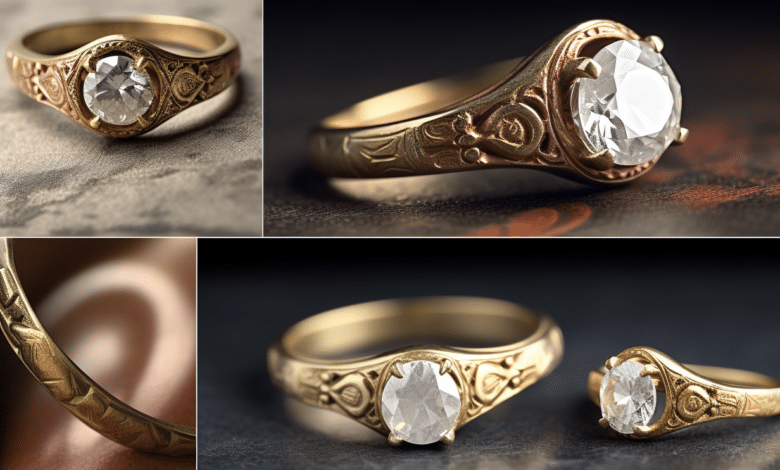6 Ways to Trace Your Vintage Ring’s History

There’s something undeniably alluring about vintage and antique rings. These timeless pieces carry a rich history that can span decades or even centuries. While their beauty is undeniable, uncovering their origins and tracing their journey through time can be a captivating endeavor. In this comprehensive guide, we’ll explore six ways to unravel the fascinating stories behind your cherished vintage ring.
1. Examining the Hallmarks
Many vintage rings bear hallmarks, which are tiny stamps or markings that provide valuable information about the piece’s origins. These hallmarks can reveal the maker, the metal purity, the year of manufacture, and even the assay office where the ring was tested and marked.
- Look for hallmarks on the inner or outer band of the ring. Common locations include the inside of the shank or the underside of the setting.
- Familiarize yourself with the various hallmark symbols and their meanings. Established jewelers often had their own unique maker’s marks, which can help identify the creator.
- Note that hallmarks were not always consistently applied, especially in earlier periods or with smaller workshops. Their absence does not necessarily negate a ring’s vintage status.
2. Evaluating the Materials and Craftsmanship
The materials and construction techniques used in a ring can offer valuable clues about its age and provenance. By carefully examining these elements, you can gain insight into the ring’s era and potential origins.
- Analyze the metal composition. Different alloys and metals were favored during specific periods, such as the use of rose gold in Victorian times or the popularity of platinum in the Art Deco era.
- Study the gemstone cuts and settings. The cuts and styles of gemstones have evolved over time, allowing experts to estimate the approximate age of a ring based on these details.
- Inspect the craftsmanship and construction methods. Antique rings were often handmade, exhibiting intricate details and techniques that can reveal clues about their origins and the skills of the artisans who created them.
3. Consulting Reputable Antique Dealers and Appraisers
While self-research can provide valuable insights, seeking the expertise of professionals can be invaluable when tracing the history of your vintage ring. Reputable antique dealers and certified appraisers possess a wealth of knowledge and experience that can help uncover the ring’s story.
- Look for dealers specializing in vintage and antique jewelry. Their expertise can help accurately date and identify the origins of your ring.
- Consider having your ring appraised by a certified gemologist or appraiser. They can provide a detailed report on the ring’s materials, craftsmanship, and estimated age, as well as valuable insights into its potential history.
- Share any background information you have about the ring’s provenance. These details can help guide the experts in their research and analysis.
4. Exploring Family Heirlooms and Genealogical Records
If your vintage ring has been passed down through generations, there may be clues hidden within your family’s history and records. Exploring these resources can yield fascinating insights into the ring’s origins and the lives of those who once owned it.
- Examine family heirlooms, such as photographs, diaries, or letters, for mentions or depictions of the ring.
- Consult genealogical records, birth certificates, marriage certificates, or wills for information about the ring’s provenance or any associated stories.
- Interview older family members or relatives who may have knowledge about the ring’s history or the individuals who once owned it.
5. Researching Historical Context and Design Trends
Every era has its distinct design trends and cultural influences that shaped jewelry styles. By delving into the historical context surrounding your vintage ring, you can gain a deeper appreciation for its origins and the era in which it was created.
- Study the design movements and artistic influences of the time period your ring is believed to be from. This can provide valuable insights into the ring’s aesthetics and cultural significance.
- Explore historical events, social trends, and cultural movements that may have influenced jewelry design and symbolism during that era.
- Examine fashion magazines, catalogs, or advertisements from the relevant time period to understand the popularity and cultural significance of certain ring styles or design elements.
6. Connecting with Online Communities and Resources
In today’s digital age, a wealth of online resources and communities dedicated to vintage and antique jewelry can aid in your research efforts. These platforms offer access to a vast repository of knowledge and allow you to connect with fellow enthusiasts and experts.
- Join online forums and social media groups focused on vintage and antique jewelry. These communities can provide invaluable insights, advice, and potential leads for your research.
- Explore online databases and archives that catalog and document historical jewelry pieces. These resources can help identify similar rings and provide context for your own piece.
- Connect with experts, historians, and authors who specialize in vintage and antique jewelry. Their wealth of knowledge and research can shed light on your ring’s origins and significance.
Tracing the history of a vintage ring is a captivating journey that can reveal fascinating stories, cultural insights, and personal connections. By employing these six methods, you can unravel the mysteries surrounding your cherished piece and gain a deeper appreciation for its enduring beauty and the rich tapestry of history it represents.











